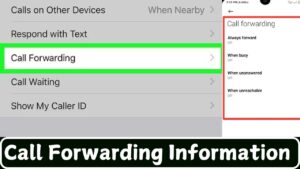Call forwarding call diversion Information
Summary of Call Forwarding
Call forwarding, or call diversion, is a telecommunication feature that redirects incoming phone calls from one number to another, ensuring that calls are not missed when the primary phone is unavailable. This service can be applied to both personal and business contexts, allowing users to manage their communications more effectively. It is used to maintain seamless accessibility, especially in situations where individuals or businesses cannot directly answer calls on their original devices.

Types of Call Forwarding
There are several types of call forwarding, each designed to cater to different scenarios:
- Unconditional Call Forwarding: All incoming calls are forwarded to another number regardless of the phone’s status. It’s ideal for extended periods when users cannot access their primary phone.
- Conditional Call Forwarding: Calls are forwarded under specific conditions, such as when the line is busy, not answered, or the phone is out of reach. It includes subtypes like forwarding when busy, no answer, or unreachable.
- Selective Call Forwarding: Only calls from specified numbers are forwarded to another line, while other calls continue to ring on the primary device.
- Remote Call Forwarding: Enables managing call forwarding settings from a remote location, which is useful for businesses with multiple offices.
- Voicemail Forwarding: Directs calls to voicemail when the recipient is unable to answer.
Benefits
Call forwarding offers numerous advantages:
- Enhanced Availability: Ensures calls are answered no matter the user’s location, ideal for those who travel frequently or work remotely.
- Improved Customer Service: Allows businesses to route calls to customer support teams, even outside regular business hours.
- Increased Productivity: Employees can handle calls while working from various locations without being tied to a single device.
- Cost-Efficiency: Businesses can save on costs by forwarding calls to VoIP services or local numbers, especially for international clients.
- Communication Flexibility: Users can customize how calls are managed under different circumstances, such as during specific times or for specific contacts.
Setup
Setting up call forwarding varies depending on the device and service provider:
- Mobile Phones: Can be configured via the phone’s settings (for Android and iPhone) or using carrier-specific codes.
- Landlines: Typically involve dialing specific activation codes or setting up through the service provider’s online portal.
Common Use Cases
- Businesses: Forward calls to different departments based on the time of day or caller’s location.
- Remote Work: Ensures employees remain accessible while working outside the office.
- Travelers: Forward calls to a local number or trusted contact abroad to avoid roaming charges.
- After-Hours Services: Forward calls to on-call employees or answering services for 24/7 availability.
Potential Drawbacks
While beneficial, call forwarding can have downsides, such as call quality issues, additional costs for forwarded calls, and management complexity if not configured correctly.
Conclusion
Call forwarding is a valuable tool for maintaining communication flexibility and accessibility, especially for businesses and individuals who are frequently on the move. It ensures that calls are not missed and enhances customer service and productivity. With various types and customizable settings, call forwarding can significantly optimize communication management.
